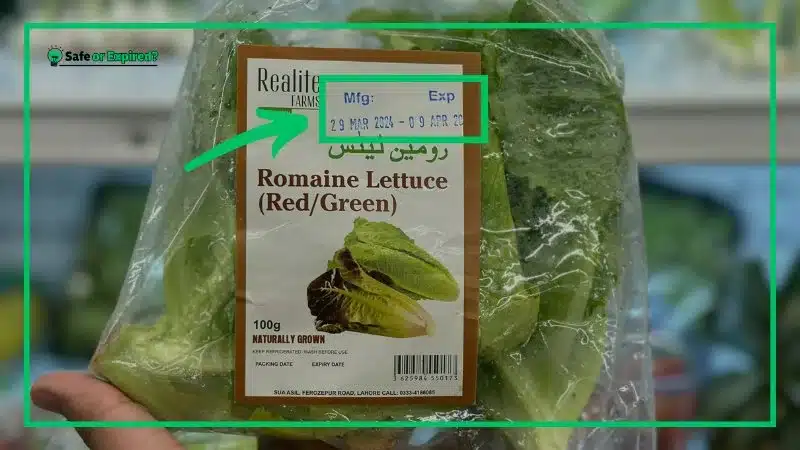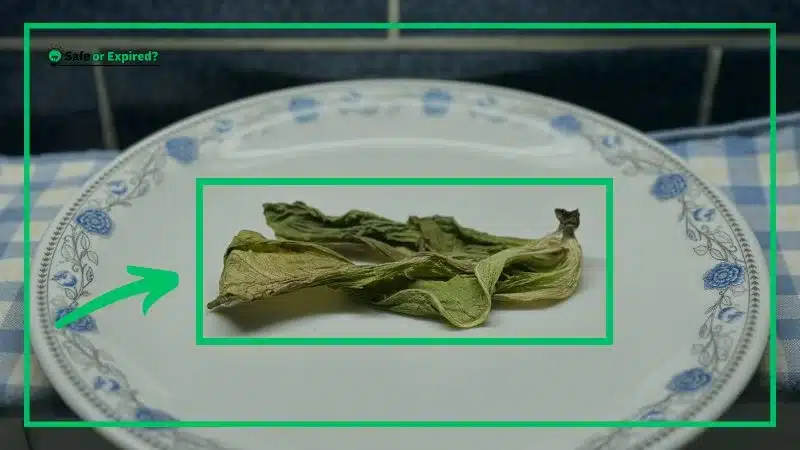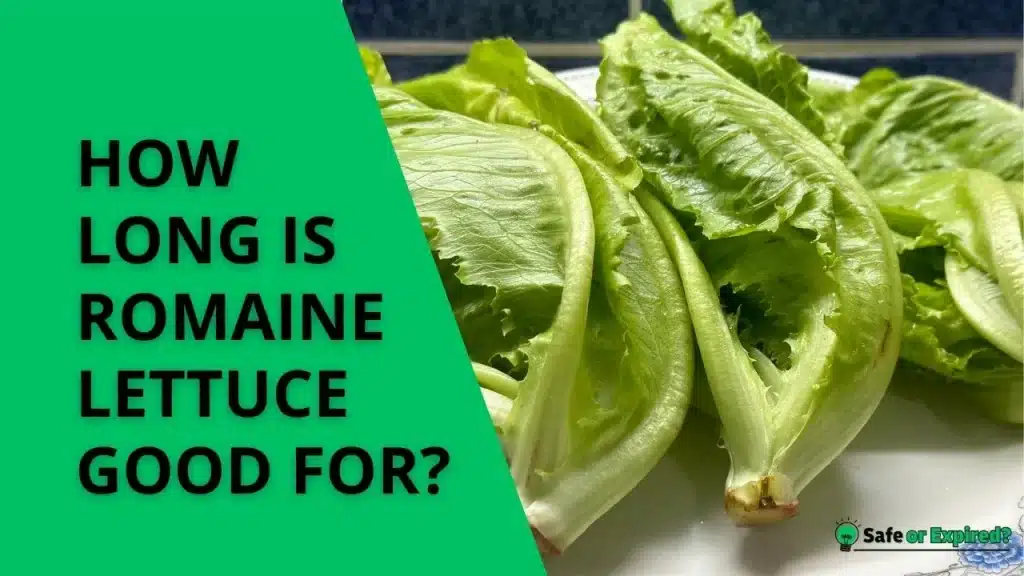“How long is romaine lettuce good for?” is a common question among those new to cooking. Well, it stays fresh for seven days, but you can keep it crisp for longer if you follow the essential tips discussed in this article. Stick around to uncover how you can enjoy crunchy, refreshing lettuce longer than you ever thought possible!
How Long Is Romaine Lettuce Good For? A General Overview
Romaine lettuce can stay good for about 7 to 10 days. Its shelf life depends on storage conditions. Typically, if stored properly, romaine lettuce can last longer. Still, it’s better if you eat romaine lettuce before the expiry date printed on its packaging.

If you want to maximize its freshness, then note that you can do this by maintaining optimal humidity and temperature conditions, as both can be considered spoilage factors if everything is not ideal. Storing romaine in a slightly damp paper towel inside a loosely closed bag in the fridge can help extend its shelf life.
Here’s a general shelf life table for romaine lettuce based on the different storage situations:
| Storage Situation | Shelf Life |
| Fresh, refrigerated | 7 to 10 days |
| Cut, refrigerated | 3 to 5 days |
| Unrefrigerated | 2 hours; 1 hour if above 90°F |
| After best by date, refrigerated | 1-3 days, if no signs of spoilage |
| In a sealed container | Up to 10 days |
| Away from ethylene-producing fruits | Extends freshness |
| Improperly stored with excess moisture | Reduces shelf life significantly |
Now, let’s start with the details.
How Long Is Romaine Lettuce Good for in the Fridge?
Romaine lettuce can stay good for up to two weeks in the fridge. However, It’s crucial to keep the lettuce away from ethylene-producing fruits. Examples are apples and bananas. These fruits can force the lettuce to spoil faster.
How Long Does Iceberg Lettuce Last in the Fridge?
Iceberg lettuce can remain fresh for about 7 to 14 days when stored in the refrigerator. To achieve this, place it in a perforated bag in the crisper drawer, ensuring it is lightly wrapped to balance air circulation and moisture.
How Long Does Lettuce Last Unrefrigerated?
Lettuce left out unrefrigerated typically lasts around 2 hours. In hotter conditions, over 90°F, its lifespan decreases to just 1 hour. To prevent spoilage, it’s crucial to keep lettuce in a cool environment.
How Long Does Romaine Lettuce Last After Cutting?
Cut romaine lettuce can stay fresh for 3 to 5 days in the refrigerator. For best results, store the cut pieces in a sealed container, making sure they are dry and kept at a consistent, cool temperature.
How Long Is Romaine Lettuce Good for After Harvest Date?
Romaine lettuce’s shelf life after harvest can extend up to 10 days if it’s handled and stored correctly immediately post-harvest. Keeping it cool and moist is crucial; farmers often use hydrocooling methods to quickly reduce the temperature of the lettuce.
Consumers are advised to store romaine in the refrigerator immediately upon bringing it home to maintain its crispness and nutritional quality.
How Long Is Lettuce Good for After Expiration Date?
The usability of lettuce after its expiration date depends on its appearance and smell. Generally, if kept in proper refrigeration, lettuce can still be safe to eat a few days past the expiration date if you don’t see any signs of spoilage like slimy leaves or an off odor.
It’s important to use your senses to assess its condition before consumption to avoid foodborne illnesses.
What Happens if You Eat Bad Lettuce? Everything You Need to Know
Eating spoiled lettuce can lead to food poisoning, characterized by symptoms such as nausea and abdominal cramps. These symptoms typically arise within a few hours of consumption and can vary in severity depending on the bacteria or pathogens present in the spoiled lettuce.
Symptoms of Food Poisoning from Lettuce
When you consume bad lettuce, the most common immediate reactions include nausea and vomiting. These are your body’s way of expelling the ingested toxins.
Apart from discomfort, eating spoiled lettuce can lead to more serious health issues. Common ones are dehydration from diarrhea. This condition requires prompt medical attention if symptoms persist.
Preventing Illness from Spoiled Lettuce
To avoid the risks associated with bad lettuce, always inspect lettuce before use for signs of spoilage, such as slimy texture and unpleasant odor. Store lettuce properly in the refrigerator to extend its freshness.
Now, you know it’s important that food is both enjoyable and safe. Learn how to manage this balance with “Best Practices for Food Quality and Safety.”
How Do I Know If My Romaine Lettuce Is Bad? Look For 5 Signs
To determine if romaine lettuce has gone bad, check for spoilage signs, such as wilting leaves, a slimy texture, discoloration, and a foul odor. Any presence of mold or excessively soft spots also indicates that the lettuce is no longer good to eat.
Wilting Leaves
When romaine lettuce starts to spoil, the first sign you might notice is the leaves beginning to wilt. Unlike fresh lettuce, which stands crisp and firm, wilted leaves feel limp and lack their usual vibrant green color.

This wilting occurs due to the breakdown of the lettuce’s cell structure, a process that accelerates when it’s exposed to excessive heat or stored improperly. Keeping lettuce cold in the fridge can slow this process, but once wilting begins, the quality degrades quickly.
Slimy Texture
A clear indication that romaine lettuce has gone bad is the development of a slimy coating on the leaves. This slime is a result of bacterial growth on the surface of the lettuce, particularly when it’s been stored in overly moist conditions.
The presence of slime not only affects the texture but also poses a health risk, as it can harbor harmful pathogens like Salmonella or E. coli. If you notice any sliminess, it’s best to discard the lettuce to avoid potential food poisoning.
Discoloration
Fresh romaine lettuce should have bright, vibrant green leaves. If you observe any brown, yellow, or black spots, this is a sign of decay or frost damage. Discoloration often occurs from improper handling or storage, where cold damage causes the cell walls in the lettuce to break down, leading to these darker spots.
These spots may also be a precursor to mold growth, making the lettuce unsafe for consumption.
Foul Odor
Any off-smelling aromas coming from your romaine lettuce are a warning sign of spoilage. Fresh lettuce should have a mild, slightly earthy smell. An unpleasant, sour, or decay-like odor is a strong indicator that your lettuce has gone bad.
This foul smell is caused by gasses released by bacteria that are decomposing the lettuce. It’s important to trust your sense of smell when assessing lettuce quality; if it smells bad, it’s safest to throw it out.
Presence of Mold
Mold growth on romaine lettuce appears as fuzzy or powdery patches of white, green, or black. Mold on any part of the lettuce suggests that it has been stored in conditions with excessive moisture and insufficient air circulation.
Mold not only affects the lettuce’s aesthetic and taste but can also produce mycotoxins, which are harmful if ingested. If you spot mold on any portion of the lettuce, do not consume it, as the spores could have spread throughout the head even if not visibly present everywhere.
Knowing what makes food spoil is crucial for prevention. Get informed about these causes in “Understanding What Causes Food to Spoil.”
How Do You Keep Romaine Lettuce Crisp? Proven Tips
To keep romaine lettuce crisp, store it in the refrigerator in a moisture-controlled environment. Use a clean, damp paper towel to wrap the lettuce and place it in a perforated bag or container to balance humidity and airflow.
Use a Damp Paper Towel
Wrapping romaine lettuce in a damp paper towel before storing it in the fridge can significantly extend its crispness. The moisture from the paper towel helps maintain an ideal humidity level around the lettuce, preventing it from drying out.
Make sure the towel is not too wet, as excessive moisture can promote rot. This method keeps the lettuce leaves fresh and crisp by mimicking a natural, dewy environment.
Store in a Perforated Bag
Storing romaine lettuce in a perforated plastic bag in the refrigerator is crucial for maintaining its crispness. The small holes in the bag allow for adequate air circulation while controlling the moisture level, which is essential to prevent spoilage and wilting.
The controlled environment helps to keep the leaves dry and crisp longer. This method strikes the perfect balance between humidity control and airflow, which is key to preserving the freshness of romaine lettuce.
Also, misinformation can lead to improper storage practices. Learn what’s accurate and what’s not in “Unmasking Myths in Food Preservation.”
Keep it Cold
Keeping romaine lettuce cold is vital for preserving its crisp texture. Store the romaine lettuce in the crisper drawer of your refrigerator, which is specifically designed to maintain the ideal temperature and humidity for fresh produce.
This drawer helps to isolate the lettuce from variations in temperature and humidity that occur with the frequent opening and closing of the door. Maintaining a consistent and cool environment slows down the degradation process and keeps the lettuce crisp.
Avoid Ethylene Producers
Keep romaine lettuce away from ethylene-producing fruits such as apples, bananas, and tomatoes. It’s because ethylene gas speeds up the ripening process in certain fruits, and it can cause vegetables like lettuce to decay quickly.
By storing your lettuce separate from these fruits, you reduce the risk of premature spoilage and wilting, thereby extending the crispness and freshness of the lettuce leaves.
Dry Thoroughly After Washing
If you wash your romaine lettuce before storing it, ensure it is thoroughly dried. Excess water can lead to a build-up of moisture in the storage container, which might promote the growth of mold and bacteria. Using a salad spinner is recommended. You can also gently pat the lettuce dry with towels, which can effectively remove excess moisture.
This step is crucial for keeping your lettuce crisp and extending its shelf life by preventing the conditions that lead to soggy, spoiled lettuce.

FAQs
Can You Eat Romaine Lettuce Every Day?
Yes, you can eat romaine lettuce every day as it is low in calories but high in fiber, vitamins, and minerals, particularly vitamins A and K. Including romaine lettuce in your daily diet can contribute to hydration and overall health due to its high water content.
How Long is Salad Good for Past the Best By Date?
A salad’s freshness past the best-by date depends on its components. A simple undressed salad like romaine lettuce can last 1-3 days past its date if stored properly in the refrigerator. However, if the salad includes dressing, meats, or eggs, it’s best consumed within 24 hours past the date.
Can You Eat Old Romaine Lettuce?
Eating old romaine lettuce is not recommended if it shows signs of spoilage, such as slimy texture, unpleasant odor, or discoloration. These indicators suggest bacterial growth, and consuming it could lead to foodborne illness.
How Do You Keep Romaine Lettuce Fresh for a Month?
Keeping romaine lettuce fresh for a month is challenging but possible with the right techniques. Store it unwashed in an airtight container in the fridge. Using paper towels is also recommended.
How Long Is Iceberg Lettuce Good For?
Iceberg lettuce is generally kept well in the refrigerator. Under ideal storage conditions, iceberg lettuce can remain fresh for about 7 to 14 days. It’s important to store it in a clean, dry environment to prevent any moisture accumulation, which can accelerate spoilage.
Conclusion
In summary, Romaine lettuce can stay good for up to 10 days. But you can keep it fresh longer with proper care:
- Proper Storage: Keep it in a perforated bag in the fridge.
- Avoid Ethylene: Store away from ethylene-producing fruits like apples and bananas.
- Regular Checks: Inspect your lettuce regularly for signs of spoilage so that it can be consumed at its best.
- Optimal Humidity: Maintain optimal humidity inside its storage container to prevent wilting.
By following these tips, you’ll ensure that your romaine lettuce remains as fresh and enjoyable as possible, adding health and flavor to your meals.

